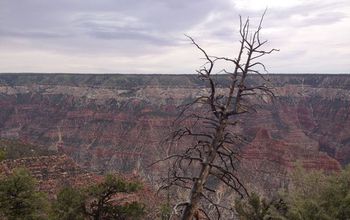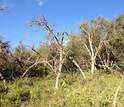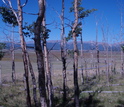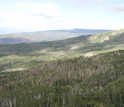News Release 16-042
Earth Week: In a drought, which trees risk death?
Study identifies tree traits that contribute to drought vulnerability

Ponderosa pine on Grand Canyon rim falling over from a drought attack.
April 18, 2016
This material is available primarily for archival purposes. Telephone numbers or other contact information may be out of date; please see current contact information at media contacts.
Drought left 225 million trees dead in the U.S. Southwest in 2002. Nine years later, it killed 300 million trees in Texas. This past year, 12 million trees died in California.
Throughout the world, large numbers of trees are dying in extreme heat and drought. Such mass die-offs can have critical consequences for the future of forests and Earth's climate. On Earth Week, scientists are trying to understand how a warming climate could affect how often tree mortality events occur -- and how severe they could become.
A University of Utah biologist may be able to help. William Anderegg and his colleagues looked for patterns in previous studies of tree mortality and found some common traits that characterized which species lived and which died during drought. The results, published today in the journal Proceedings of the National Academy of Sciences (PNAS), can help chart the future of forests.
"There are some common threads that we might be able to use to predict which species are going to be more vulnerable in the future," Anderegg says.
Forests in crisis
"With drought projected to increase, predicting tree death is imperative to understanding changes in Earth's forests," says Liz Blood, program director in the National Science Foundation (NSF) Division of Environmental Biology, which funded the research. "This study offers important new insights into how and why trees die from drought, and which trees are at greatest risk."
Worldwide, forests absorb the equivalent of about one-quarter of the carbon dioxide emissions humans produce. So large-scale tree die-offs not only shut down a forest's ability to sequester greenhouse gases but also release some of those gases back into the atmosphere as dead trees decompose.
In climate models, scientists have had difficulty accounting for these changes in carbon dioxide storage. The effect of drought on various species' mortality rates has been difficult to predict. "That launched this search to understand what about a tree's physiology predisposes it to die during a severe drought," Anderegg says.
The researchers combed through 33 published studies of tree mortality that included 475 tree species and more than 760,000 individual trees. The team noted mortality rates for each species, then compared those to 10 tree physiological traits, searching for commonalities.
The traits included typical tree characteristics such as wood density, rooting depth and basic leaf characteristics, and whether the species was evergreen or deciduous. Other traits concerned the hydraulics of how water moves through trees.
Tree 'heart attack'
The researchers found only three traits that significantly predicted tree drought mortality, all of which related to hydraulics.
Roots take in water, which is pumped throughout the tree to hydrate leaves and support photosynthesis. In times of plenty, water moves easily through the tree. But when temperatures increase, evaporation from leaves drives higher water demand.
At the same time, if drought makes water harder to come by, the tree's roots have to pull harder to draw scant moisture from the soil. Tension builds in the tree's "pipes" as they work harder and harder to move water, like a person trying to suck a thick smoothie through a small straw.
At a certain point, tension on the "pipes" becomes so great that bubbles of air enter them and block water flow. The result is called an embolism.
"It's a little bit akin to a tree heart attack," Anderegg says. "You can actually hear this on a hot summer day if you stick a microphone up to a tree -- you can hear little pings and pops as these pipes get filled with air." Blocked pipes lead to tree death.
The three traits Anderegg found that significantly affected tree mortality were:
- The point at which a tree loses 50 percent of its hydraulic conductivity due to embolism.
- The point at which a tree loses 88 percent of total hydraulic conductivity.
- The hydraulic safety margin, the range between the tension of water the tree allows during dry conditions and the tension that causes hydraulic dysfunction.
Other traits did not affect tree mortality nearly as much as these characteristics. Anderegg says trees accustomed to plentiful water, such as trembling aspens, are more susceptible than junipers, which are better adapted to dry conditions.
Signs of climate change
The next step is to incorporate these traits into climate models and forest models to help public and private land managers forecast which trees might be most susceptible to drought.
Anderegg says that recent tree-killing droughts in the western U.S. were marked more by elevated temperature -- a sign of a warming world -- than by a lack of rainfall.
"These widespread tree die-offs are a really early and visible sign of climate change already affecting our landscapes," he says.
-NSF-
-
Dead oak trees line a forest near Mancos, Colorado.
Credit and Larger Version -
These trembling aspen trees near Fairplay, Colorado, were killed by severe drought.
Credit and Larger Version -
Drought stress felled these trembling aspens near Flagstaff, Arizona.
Credit and Larger Version -
Dead trees from recent droughts in the San Juan National Forest near Mancos, Colorado.
Credit and Larger Version -
Drought near Grand Junction, Colorado, resulted in the deaths of many trembling aspens.
Credit and Larger Version
Media Contacts
Cheryl Dybas, NSF, (703) 292-7734, email: cdybas@nsf.gov
Paul Gabrielsen, University of Utah, (801) 585-6861, email: paul.gabrielsen@utah.edu
Related Websites
NSF Grant: Extreme Events and Ecological Acclimation: Scaling from Cells to Ecosystems: http://www.nsf.gov/awardsearch/showAward?AWD_ID=1340270&HistoricalAwards=false
The U.S. National Science Foundation propels the nation forward by advancing fundamental research in all fields of science and engineering. NSF supports research and people by providing facilities, instruments and funding to support their ingenuity and sustain the U.S. as a global leader in research and innovation. With a fiscal year 2023 budget of $9.5 billion, NSF funds reach all 50 states through grants to nearly 2,000 colleges, universities and institutions. Each year, NSF receives more than 40,000 competitive proposals and makes about 11,000 new awards. Those awards include support for cooperative research with industry, Arctic and Antarctic research and operations, and U.S. participation in international scientific efforts.
Connect with us online
NSF website: nsf.gov
NSF News: nsf.gov/news
For News Media: nsf.gov/news/newsroom
Statistics: nsf.gov/statistics/
Awards database: nsf.gov/awardsearch/
Follow us on social
Twitter: twitter.com/NSF
Facebook: facebook.com/US.NSF
Instagram: instagram.com/nsfgov





